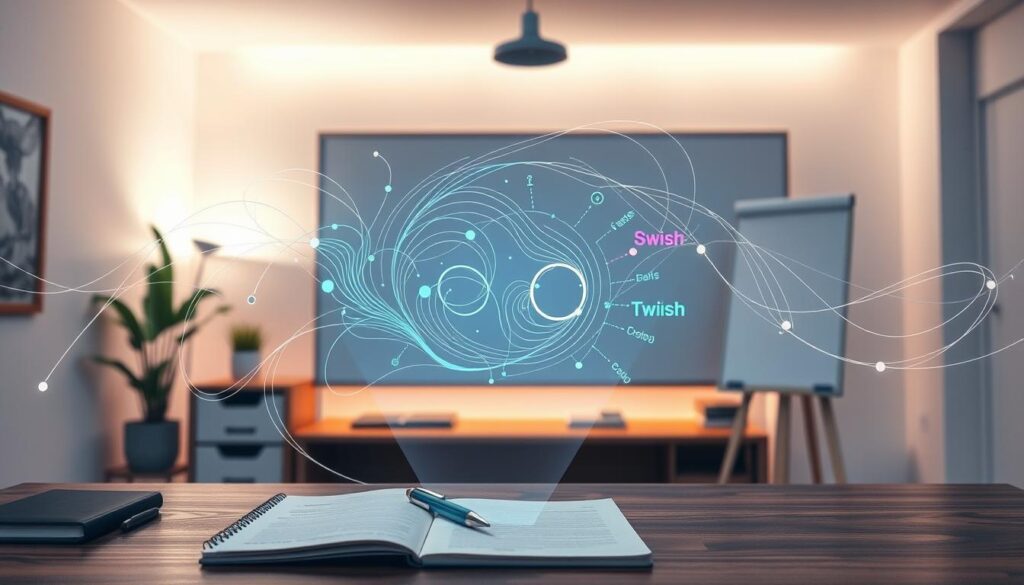“Your vision will become clear only when you can look into your own heart. Who looks outside, dreams; who looks inside, awakes.” – Carl Jung’s words capture the essence of reshaping mental patterns through intentional focus. What if you could rewire stubborn negative thoughts in seconds? A powerful method exists to do exactly that.
This approach relies on altering how the mind processes visual cues. By adjusting elements like brightness, size, and clarity of mental images, individuals can disrupt unhelpful habits. The key lies in replacing a triggering picture with an aspirational self-image rapidly – often within moments.
Imagine swapping frustration with confidence as easily as flipping a light switch. Clients report dramatic shifts when they master this process. Speed matters: the faster the transition between states, the more effectively new patterns stick. This isn’t just positive thinking – it’s strategic reprogramming of the brain’s visual language.
Key Takeaways
- Visual mental adjustments can directly influence behavior and emotional states
- Brightness and focus changes disrupt ingrained negative thought loops
- Speed of image replacement determines effectiveness
- Personalized motivational imagery creates lasting change
- Practice builds neural pathways for automatic positive responses
Understanding the Fundamentals of the NLP Swish Technique
In the 1980s, innovators studied how certain individuals effortlessly broke habits. They noticed people naturally replaced unwanted behaviors by shifting their mental focus. This discovery became the foundation for a method now used globally to rewire reactions.

The Origins and Evolution of the Swish Pattern
Developers like Richard Bandler observed successful habit changes in everyday life. A person overcoming nail-biting, for example, often visualized clean hands instead of the urge. By modeling these natural processes, experts created structured steps anyone could follow.
Early practitioners tested adjustments to internal pictures – making triggers dimmer while amplifying desired outcomes. This approach evolved into a precise tool for coaches and therapists. Over years, it proved effective for smoking cessation, stress eating, and other challenges.
The Science Behind Changing Submodalities
Our brains code experiences through sensory details called submodalities. Brightness, size, and location of mental images directly affect emotional responses. When a client dulls a craving’s visual intensity, the associated feeling weakens.
Here’s how it works: A coach guides someone to shrink their trigger image while expanding a positive self-view. Rapidly swapping these pictures – like flipping a mental slideshow – builds new neural pathways. Studies show faster transitions create stronger behavioral shifts.
Step-by-Step Implementation of the NLP Swish Pattern
Transforming thought patterns requires deliberate action. This method uses visual cues to rewire automatic responses – like hitting a mental reset button. Let’s break down the practical stages.

Identifying Trigger Images and Unwanted Behaviors
Start by pinpointing the mental picture linked to your habit. Does stress-eating begin with imagining a chocolate bar’s shiny wrapper? Notice where this trigger image appears in your mind’s eye – left, right, or center.
Creating and Enhancing Your New Self-Image
Design a vivid image of your desired outcome. Make it compelling: see yourself calm and confident, not reaching for snacks. Amplify brightness and add empowering details – maybe a radiant smile or confident posture.
Executing the Rapid Swish Process
Now comes the magic. Shrink the trigger picture while expanding your new self-view. Push the old image to a mental corner as the new one zooms into focus. Repeat this process seven times at lightning speed.
| Element | Old Image | New Image |
|---|---|---|
| Brightness | Dim | Vibrant |
| Focus | Blurry | Crystal-clear |
| Emotional Impact | Anxiety | Empowerment |
Speed matters – complete each swap in under a second. This rapid-fire approach helps bypass old neural pathways. With practice, your mind will automatically choose the positive image when triggers arise.
Common Challenges and Expert Advice on the NLP Swish Technique
Even proven methods occasionally hit roadblocks. When the swish pattern doesn’t deliver results, practitioners often trace issues to overlooked details in execution or design. Let’s explore solutions to frequent hurdles.

Troubleshooting When the Technique Doesn’t Work
A dim or fuzzy replacement image undermines effectiveness. If the new self-view feels like a distant fantasy, the client’s mind rejects it. Coaches recommend grounding visions in achievable traits – like confidence in specific situations rather than superhero abilities.
Speed errors also derail progress. Sluggish transitions between trigger and desired states weaken neural rewiring. One detailed guide on mastering the swish suggests practicing rapid swaps until they feel automatic. “It’s like changing TV channels faster than doubt can interrupt,” explains a seasoned practitioner.
Ensuring the New Self-Image is Realistic and Inspirational
The ideal mental picture balances aspiration with authenticity. A recovering public speaker might visualize steady hands and calm breathing – not a flawless Tony Robbins performance. Details matter: crisp visuals with natural lighting enhance believability.
Watch for subtle cues during sessions. If a client’s eyes dart upward or their posture slumps, their replacement image lacks emotional resonance. Adjust brightness or add movement until it sparks genuine motivation. As one coach notes, “The right image feels like recognizing your future self.”
Integrating the NLP Swish Technique Into Daily Life
Daily routines become transformation tools when paired with intentional visualization. One client replaced afternoon sugar cravings by mentally “swishing” candy wrappers into images of fresh berries. Within three weeks, their grocery choices shifted naturally.
Building Lasting Positive Habits
Consistency turns temporary changes into automatic responses. Life coach Seth Hall recommends pairing the pattern with existing habits: “Link your morning coffee to visualizing daily wins.” This anchors new neural pathways through repetition.
| Old Habit | New Response | Daily Practice |
|---|---|---|
| Reaching for phone when stressed | Visualizing deep breathing | 3 swishes before lunch |
| Procrastination triggers | Seeing completed tasks | 5-second image swaps |
| Self-doubt moments | Confident posture memory | Evening reflection |
Real-Life Examples and Success Stories
A sales professional used rapid image replacement to conquer call anxiety. “I’d shrink the shaking phone and expand myself giving a TED talk,” she shares. Within a month, her conversion rate jumped 40%.
Coaches emphasize tracking subtle shifts. One client journaled how chocolate cravings faded as her “healthy self” picture grew brighter. “The mind accepts what we consistently show it,” notes Hall in his guide to mindset shifts.
Weekly check-ins with a coach help refine the process. Small tweaks – like adjusting mental lighting or adding movement to desired images – often create breakthroughs. The key lies in treating mental rehearsal like physical exercise: brief, daily, and purposeful.
Conclusion
The journey to lasting change begins with mastering your mind’s visual language. By strategically adjusting mental images – dimming triggers while amplifying desired states – this pattern rewires deep-seated thoughts. Decades of real-world use prove its effectiveness when applied with precision and speed.
Success hinges on crafting replacement pictures that feel both achievable and inspiring. A client visualizing calm confidence during stress sees better results than one imagining unrealistic perfection. Coaches emphasize consistent practice to solidify new neural pathways – the brain learns through repetition.
Every moment offers a choice: reinforce old patterns or create empowering ones. Case studies show people transforming anxiety into action by applying these principles in critical situations. Whether overcoming procrastination or self-doubt, the method adapts to various life challenges.
Ready to shift your mental landscape? Start with one recurring pattern today. Track how changing its visual components alters associated feelings. With time, you’ll develop an intuitive skill for maintaining positive states – your future self will thank you.
FAQ
How does changing mental imagery create lasting behavioral shifts?
The method works by reprogramming how the brain processes triggers. By altering submodalities—specific details like brightness, size, or location of mental images—you rewire automatic responses. This helps replace unwanted habits with empowered reactions anchored in your upgraded self-image.
What makes the replacement image effective for breaking old patterns?
A compelling new self-image must feel authentic and aspirational. Coaches emphasize adding vivid sensory details—how you stand, speak, or move in that ideal state. When this vision aligns with core values, it generates intrinsic motivation to override past conditioning.
Why might someone struggle to “feel” the technique’s effects initially?
Common hurdles include unclear triggers or generic replacement images. Master practitioners recommend adjusting sensory elements—making the desired image brighter or closer—until it sparks genuine positive emotion. Pairing the exercise with anchoring techniques often strengthens neural associations.
Can this approach help with deeply ingrained habits formed over years?
Yes, but consistency matters. Research shows repeating the swish process 5-7 times daily for three weeks creates durable neural pathways. Many users report faster shifts when combining it with mindfulness practices or cognitive behavioral strategies.
How do coaches ensure clients don’t develop unrealistic expectations?
Ethical practitioners stress gradual integration. They guide clients to set milestone-based goals—like reducing snack cravings by 30% weekly—while celebrating small wins. This builds confidence in the technique’s real-world applicability.
What real-world results do people typically experience first?
Early successes often include reduced anxiety around triggers and spontaneous positive reactions. One case study showed a sales professional overcoming call reluctance within 10 days by visualizing confident client interactions during practice sessions.




























































